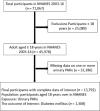Association between urinary polycyclic aromatic hydrocarbon metabolites and diabetes mellitus among the US population: a cross-sectional study
- PMID: 35751578
- PMCID: PMC9977221
- DOI: 10.1093/inthealth/ihac029
Association between urinary polycyclic aromatic hydrocarbon metabolites and diabetes mellitus among the US population: a cross-sectional study
Abstract
Background: The primary aim of this study is to examine the association between urinary polycyclic aromatic hydrocarbons (PAHs) and diabetes mellitus (DM) among the US population.
Methods: We used data from the National Health and Nutritional Examination Survey 2003-16, which is a nationally representative population-based survey of the US non-institutionalized population. Logistic regression analysis was performed to evaluate the association between urinary PAHs and the prevalence of DM using odds ratios (ORs) and 95% confidence intervals (CIs).
Results: The study sample including 13 792 individuals ≥18 y of age. The average ages of the three PAH tertiles were 42.56±19.67, 42.21±19.51 and 43.39±17.99 y. An increased risk of DM was found with increased odds for the second (OR 1.56 [95% CI 1.36 to 1.79]) and third tertile (OR 1.79 [95% CI 1.55 to 2.06)] of urinary PAH as compared with the first tertile. Similarly, higher chances of DM were observed in the second (men: OR 1.42 [95% CI 1.18 to 1.71]; women: OR 1.76 [95% CI 1.44 to 2.14]) and third tertile (men: OR 1.69 [95% CI 1.38 to 2.08]; women: OR 1.79 [95% CI 1.46 to 2.19]) of urinary PAHs as compared with the first tertile in both men and women.
Conclusions: A population-based cross-sectional study found a positive association between urinary PAHs and DM in the US population.
Keywords: diabetes mellitus; environmental contaminate; polycyclic aromatic hydrocarbon; urinary PAH.
© The Author(s) 2022. Published by Oxford University Press on behalf of Royal Society of Tropical Medicine and Hygiene.
Figures
Similar articles
-
Association of urinary polycyclic aromatic hydrocarbon metabolites and cardiovascular disease among US population: A cross-sectional study.Environ Res. 2022 Jun;209:112775. doi: 10.1016/j.envres.2022.112775. Epub 2022 Jan 20. Environ Res. 2022. PMID: 35065070
-
Studying the effects of polycyclic aromatic hydrocarbons on peripheral arterial disease in the United States.Sci Total Environ. 2013 Sep 1;461-462:341-7. doi: 10.1016/j.scitotenv.2013.04.089. Epub 2013 Jun 5. Sci Total Environ. 2013. PMID: 23747551
-
Urinary polycyclic aromatic hydrocarbons and adult obesity among the US population: NHANES 2003-2016.Clin Obes. 2024 Oct;14(5):e12687. doi: 10.1111/cob.12687. Epub 2024 Jul 4. Clin Obes. 2024. PMID: 38965765
-
The association between urinary metabolites of polycyclic aromatic hydrocarbons and diabetes: A systematic review and meta-analysis study.Chemosphere. 2020 May;247:125680. doi: 10.1016/j.chemosphere.2019.125680. Epub 2020 Jan 8. Chemosphere. 2020. PMID: 32069705
-
The Association between Urinary Polycyclic Aromatic Hydrocarbons Metabolites and Type 2 Diabetes Mellitus.Int J Environ Res Public Health. 2022 Jun 22;19(13):7605. doi: 10.3390/ijerph19137605. Int J Environ Res Public Health. 2022. PMID: 35805265 Free PMC article.
Cited by
-
Effects of single and combined urinary polycyclic aromatic hydrocarbon effects on lung function in the U.S. adult population.BMC Public Health. 2024 Oct 11;24(1):2778. doi: 10.1186/s12889-024-20267-5. BMC Public Health. 2024. PMID: 39394095 Free PMC article.
-
Urinary polycyclic aromatic hydrocarbon metabolites and hyperlipidemia: NHANES 2007-2016.Lipids Health Dis. 2024 May 27;23(1):160. doi: 10.1186/s12944-024-02153-6. Lipids Health Dis. 2024. PMID: 38802874 Free PMC article.
-
Diabetes: a potential mediator of associations between polycyclic aromatic hydrocarbon exposure and stroke.Environ Sci Pollut Res Int. 2024 Feb 9. doi: 10.1007/s11356-024-32324-y. Online ahead of print. Environ Sci Pollut Res Int. 2024. PMID: 38332417
-
Environmental contamination with polycyclic aromatic hydrocarbons and contribution from biomonitoring studies to the surveillance of global health.Environ Sci Pollut Res Int. 2024 Sep;31(42):54339-54362. doi: 10.1007/s11356-024-34727-3. Epub 2024 Aug 29. Environ Sci Pollut Res Int. 2024. PMID: 39207613 Free PMC article. Review.
References
-
- Guariguata L, Whiting DR, Hambleton Iet al. . Global estimates of diabetes prevalence for 2013 and projections for 2035. Diabetes Res Clin Pract. 2014;103(2):137–49. - PubMed
-
- Bommer C, Heesemann E, Sagalova Vet al. . The global economic burden of diabetes in adults aged 20–79 years: a cost-of-illness study. Lancet Diabetes Endocrinol. 2017;5(6):423–30. - PubMed
-
- Bommer C, Sagalova V, Heesemann Eet al. . Global economic burden of diabetes in adults: projections from 2015 to 2030. Diabetes Care. 2018;41(5):963–70. - PubMed
Publication types
MeSH terms
Substances
LinkOut - more resources
Full Text Sources
Medical


